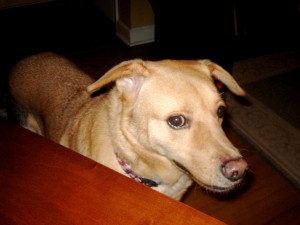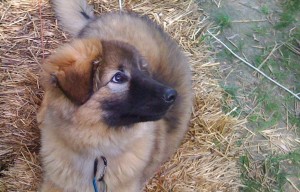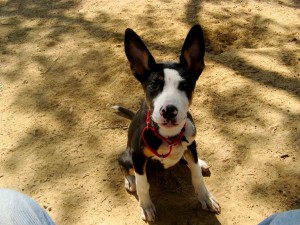 I promote no suggestions to interrupt a dog during elimination. Instead, focus on preventing accidents. Keep a log. Watch your pup closely. Observe your dog’s behavior when he eliminates outside so you will recognize signs of “hunting for a location” like sniffing, and circling.
I promote no suggestions to interrupt a dog during elimination. Instead, focus on preventing accidents. Keep a log. Watch your pup closely. Observe your dog’s behavior when he eliminates outside so you will recognize signs of “hunting for a location” like sniffing, and circling.
When you notice any pre-elimination behaviors while you are inside, tell your pup, “let’s go potty”, pick up your puppy and carry him outside to the desired location.
I know some very reliable sources instruct owners to kindly interrupt their untrained puppy (if they catch him in the act) and then take him outside.
The suggestions include actions such as softly clapping your hands, saying “ehh ehh”, shaking a can with pennies, or even tossing a magazine or keys on the floor beside the pup. I don’t like any of these suggestions. Some pups are confident and others are shy and some are in-between. The same interrupter will be received differently by each pup.
If the interrupter you choose terrifies your pup, you might as well have kicked your dog.
If your pup is confident and playful, he might respond to interrupters as Bentley did –gleeful fleeing while peeing! Yikes!
Another point to consider is this. If people are instructed to use some sort of mild interrupter to reduce behaviors, what will their next choice be when the interrupter fails to reduce the behavior? I know what their choice will be because I am no different. My next choice would be stronger interrupters – which will certainly hamper the house training process.
I’m not sure why professionals who suggest interrupting don’t clarify their suggestions with this statement:
“Interrupters will not hasten the house training process. At best, interrupters will stop the dog in the act and you’ll have a smaller area to clean. At worst, interrupters will teach your dog to fear you and to hide from you when he eliminates”.
Clean Up
Expect accidents. No matter how careful you are, there will be occasions when your pup piddles and poops on your floor. It’s nobody’s fault. It happens. The damage is done.
Try not to fuss at your spouse or your kids, yourself or your pup. Just remember, if it happens frequently, you should review this guide and make changes that will reduce your pup’s opportunities to eliminate inside.
Clean the affected area with an enzyme-based, odor neutralizer.
Any commercial product that specifically states “For Pet Odors” is sufficient.
It takes several days for the enzymes to break down the odors. Your dog will smell the urine and be attracted to the area long after you apply cleaners.
Whenever liquids are spilled on carpet, the carpet pad acts as a sponge and soaks up the liquid.
The urine is spread over a larger area in the pad than is indicated by looking at the carpet.
Generously apply the cleanser to an area equal to twice the size of the observable stain.
If you have “pet proof” padding installed under your carpet, the affected area underneath the carpet will be even larger. Pet proof padding has a plastic coating on top to prevent liquids from seeping into the pad. This causes the urine to spread underneath the carpet until it is absorbed by the carpet backing, instead of the pad. Treat a much larger area than is indicated by the wetness of the carpet fibers.
If you don’t have any cleanser, use a solution of 1 part distilled, white vinegar to 4 parts water. Do not use ammonia based cleaners. Ammonia breaks down into urea, which is a component of urine.
Do not use any cleaners that are not specifically marketed to neutralize odors. Non specific cleaners will set the stain and the smell.
Before you hire a carpet cleaning service, verify that they use an odor neutralizer with enzymes.
If the smell is set into the flooring, your dog will always be drawn to eliminate in that area. It’s impossible to remove urine odors from concrete and other non-sealed, porous flooring materials. If you have any permanently-soiled areas, you may need to deny your dog unsupervised access to that area forever.
Happy Training!
Alan J Turner – How’s Bentley – Memphis
Companion Animal Behavior Counselor – Canine Specialization
 Contrary to popular beliefs, the process of house training is largely governed by a naturally occurring, classical conditioning process. I propose we assign a more accurate, 21st century, label for house training. Let’s name it “potty area conditioning”!
Contrary to popular beliefs, the process of house training is largely governed by a naturally occurring, classical conditioning process. I propose we assign a more accurate, 21st century, label for house training. Let’s name it “potty area conditioning”!


